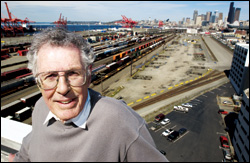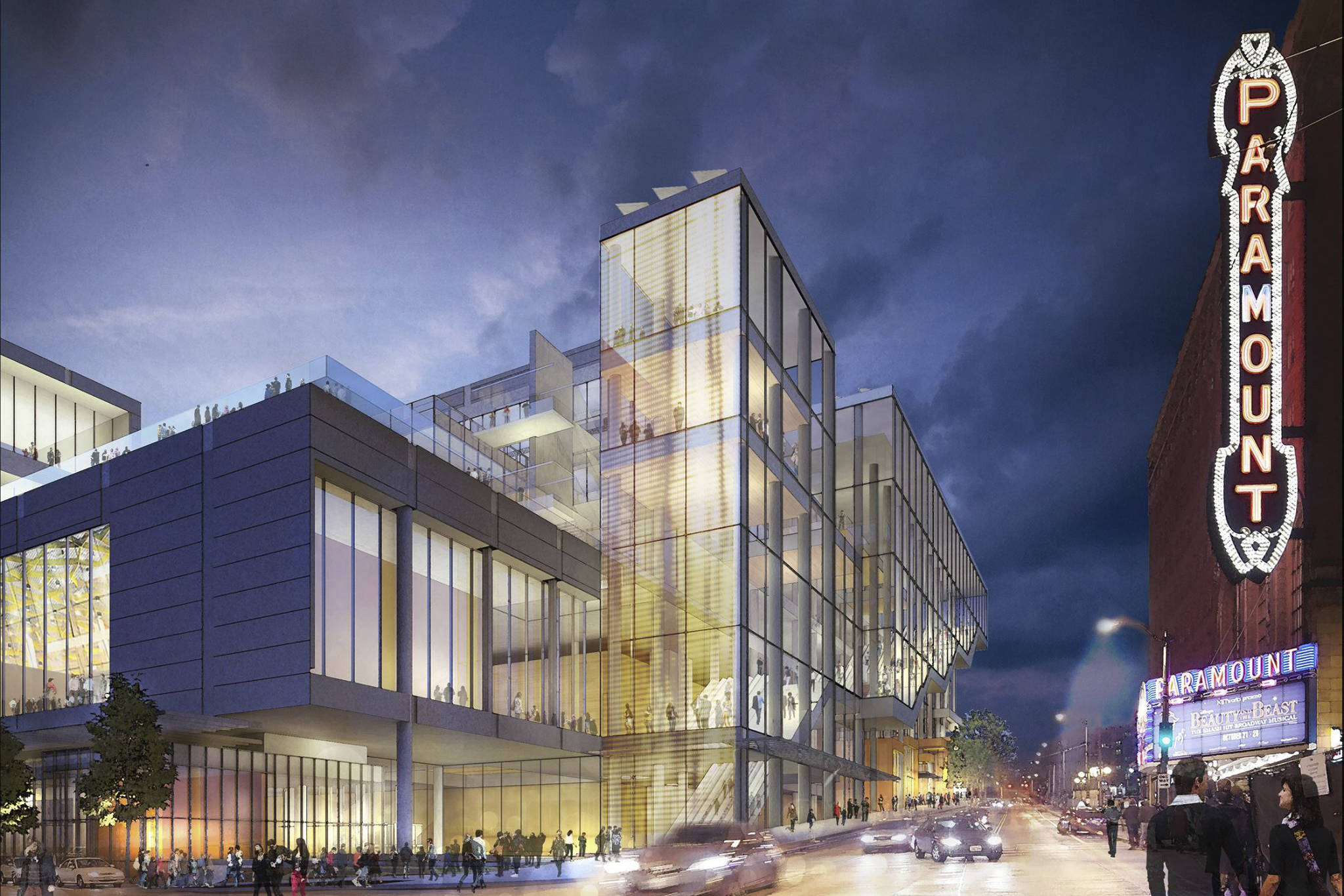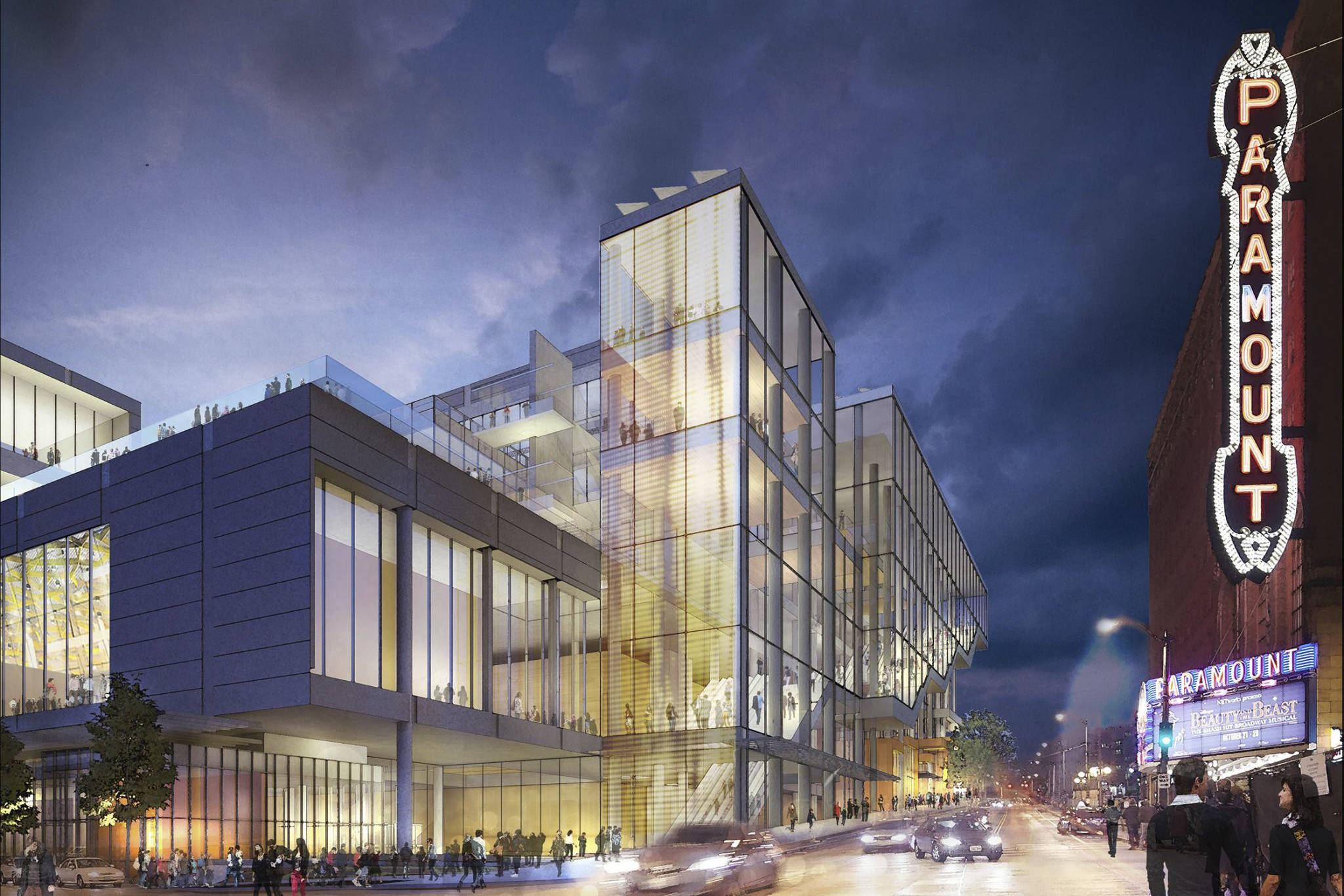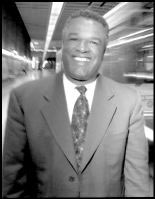Yuppie flu is spreading through blue-collar Seattle, and Terminal 46 is the hot zone. The gentrification contagion started with Safeco Field and Seahawks Stadium and is now threatening to spread west to the 88-acre container-shipping terminal, the last big facility of the marine industry next to downtown.
You have seen 46’s three towering orange cranes south of the ferry dock. They are the biggest container cranes in the world, standing 120 feet tall and costing $7 million apiece. But they represent just a fraction of the $70 million in public investment that is pouring into Terminal 46 from its owners, the Port of Seattle.
Terminal 46 provides 1,336 jobs and results in $73.4 million annually in personal income and $69.6 million in state and local tax revenue. The jobs are good-paying, unionized, blue-collar employment—longshoremen, truckers, and railway workers—precisely the kind of work that Seattle, and the U.S. in general, is desperate to hold on to in this age of outsourcing.
What could fell such a colossus? Try condos, high-tech office space, sweeping parks, and a new sports arena. Frank Stagen, 69, CEO of Nitze-Stagen, is a creative, brilliant, and shrewd player in Seattle’s development community and has set his sights on what he says might be the most valuable piece of real estate in Seattle.
Stagen contends that change will sweep away industry at Terminal 46, and rather than be passive and haphazard about the process, Seattle should be bold and decisive and build an iconic structure similar to the Sydney Opera House amidst a 21st-century creative community of housing, offices, and green space. It would, Stagen thinks, simultaneously propel the economy and be a model for how the city can grow up instead of sprawling farther out. Stagen sees such great potential for the site not only because it is larger than Seattle Center’s 74 acres and is on the water, but because it would be a blank slate where developers would be unencumbered by existing buildings or the street grid. Call it the Seattle Commons on the Sound.
Stagen and his allies also want the city to approve a host of zoning changes for the SoDo neighborhood, Pioneer Square, and the International District to encourage greater residential density throughout the area south of downtown.
Despite Mayor Greg Nickels’ repeated declarations of support for preserving Seattle’s remaining industrial lands, hizzoner also thinks that Terminal 46 will, in the long run, be converted to a mixed-use neighborhood by somebody. Deputy Mayor Tim Ceis says the mayor expects Terminal 46 to remain industrial at least through 2015, because of the likely extension of an existing lease; but after that, the site’s prime waterfront location means it’s destined for nonindustrial use. While Ceis acknowledges that 11 years seems like a long time from now, he thinks Seattle needs to better plan for its future. “It’s good to think long term,” Ceis says. “The view of Seattle has always been short term.”
Nitze-Stagen’s president, Kevin Daniels, echoes those points. After South Lake Union is developed, Daniels says, Terminal 46 is the next place for Seattle to grow. In development terms, 2015 is just around the corner. “Let’s discuss it now before it’s too late,” says Daniels.
Ceis also says the mayor supports Stagen’s effort to produce more housing in the south end of downtown and will propose a package of zoning changes within the next year.
Against this powerful assembly of real-estate interests and political machinery stands another man with great ambitions that turn on Terminal 46, and he’s putting together his own coalition of economic and political power. New Port Commissioner Alec Fisken is an unlikely advocate for the city’s gritty blue-collar industries. The 56-year-old, brainy graduate of Yale and Harvard, where he got a master’s degree in public administration, makes his daily bread as a policy adviser for the mayor. (Port commissioners are paid $500 a month plus per-diem expenses for their part-time work.) Fisken thinks the Port of Seattle can turn its seaport into a profitable venture by making alliances with other Northwest ports and setting minimum rents on container shipping terminals. In short, flexing a little muscle in the marketplace.
In defense of the working waterfront, Fisken finds himself part of a motley coalition that includes two of the other four Port commissioners. Standing firm against a change of use for Terminal 46 are the fast-talking, labor-backed, environmentalist engineer Lawrence Molloy and the 18-year veteran of the commission, Pat Davis, a global-trade advocate who received notoriety—and brickbats—for bringing us the World Trade Organization conference in 1999. “We can have condos and sports stadiums lots of places,” notes Davis, “but you can’t bring container ships up Third Avenue.” These three commissioners disagree on many other things, but they all believe that Terminal 46 is a unique facility for marine industrial use that, if lost to mixed-use development, could never be re-created elsewhere in Seattle.

(Vision 46) |
Terminal 46 sits on deep water that allows the huge container ships to approach without the expensive dredging that ports in other cities have to do. Just one mile down the road is the Seattle International Gateway, a railroad yard where containers that arrive by water from Asia can be shipped east. The terminal also has good access to Interstate 5 and Interstate 90 for containers being carried by truck.
Terminal 46 gives its tenant a prestigious location on the waterfront. Hanjin, the Korean shipping line, has occupied the terminal since 1986 and has resisted Port overtures to move elsewhere in the harbor. The company has a lease that runs through 2010, with the option to renew through 2015.
Can these three commissioners fight the money and power being assembled against them?
“There is some inexorability to the conversion of the waterfront,” says University of Washington political scientist David Olson, a Port expert. “Some large financial interests already have the schematics ready for how to transform it.” He looks forward to a robust debate. “This question of redevelopment is pitting Seattle’s long maritime tradition against a vision of the postindustrial city that says blue-collar jobs are negotiable.”
City of Density
Frank Stagen wants Seattle to make a conscious choice about its future. “Just once, can’t this city plan for its own destiny?” he asks rhetorically. And just to start the conversation, Stagen spent “a lot of money” to prepare a blueprint for a whole new section of the city to be developed on Terminal 46, called “South Waterfront.” It would be difficult to overstate the ambition of his vision. It includes the Overlook, a neighborhood of 3 million square feet of office space for 8,000 workers; two residential neighborhoods—the Villa and the Parterre—with housing for 4,200 people; a cruise-ship terminal; a new sports arena, presumably for the Sonics; an inner harbor for yachts or a mosquito fleet; a large public piazza surrounded by stores; a five-star hotel; the Quay, a park running 3,000 feet along the waterfront; the Long Garden, at the center of the neighborhood; and a trade conservatory that would feature export products from Washington state. (See www.vision-46.com.) “Sydney, Australia, is known for its harbor-front opera house. We believe this proposal has the potential to build the same kind of iconic landmarks on Seattle’s waterfront,” says Stagen.
The site is not an end in itself, however. Stagen believes that in order to save the region from becoming an endless sprawl of traffic and strip malls, Seattle must grow more dense. The South Waterfront project could be an example of how to do that and still preserve the region’s much desired livability. “You cannot effectuate these changes with a 15,000- to 20,000-square-foot property. The only piece of land available in the city is Terminal 46,” says Stagen.
No one disputes Stagen’s knowledge of the local real-estate market, especially in SoDo and Pioneer Square. Founded in 1970, Nitze-Stagen has 22 employees and manages about 3 million square feet of property in the Puget Sound area. Its marquee property is the 2 million-square-foot Starbucks Center—SoDo’s old Sears building on Utah Avenue South that now houses the headquarters of Seattle’s coffee giant.
“I don’t underestimate Frank Stagen ever—not many people do,” says Deputy Mayor Ceis. “He’s real smart, he’s a great guy, and he’s an interesting guy. He’s pretty good at knowing how to work folks.”
Even Port Commissioner Fisken praises Stagen’s plan for Terminal 46 as having a lot of imagination and vision, although, he quickly adds, “too bad it’s at the wrong place.”
Stagen has never done a project of this magnitude. He says he has a big partner ready to work with him. “One of the major real- estate development firms in the world came in and looked at this and said, ‘We would like to form an alliance with you in the development of this project,'” he states.
Some observers are skeptical and wonder if Stagen isn’t playing a very different game. David Brewster, former editor of Seattle Weekly and current director of Town Hall, knows Stagen and has watched many waterfront redevelopment plans come and go. Says Brewster: “That is a kind of a play to get upzoning in there.” In other words, the big vision is just a gambit to get the city to allow taller buildings upland from Terminal 46.
Seattle City Council Urban Development and Planning Chair Peter Steinbrueck echoes those concerns. “There’s a lot of competition going on with developers’ wet dreams,” says Steinbrueck, an architect. “The economy is down, commercial development is down. It’s a good time to try to sell plans to the city and get regulations lifted by the city. It seems absurd to consider other uses for that site when there is a viable industrial use there.”
Steinbrueck urges caution. “SoDo property owners and developers have put a lot of time and money into plans,” he notes. “We have to be leery of proposals that can be a bait and switch. The land value can be significantly enhanced through rezoning. The owners cash in and go on their merry way.”
The Mayor Loves Developers
Terminal 46 is, after all, only part of an ambitious transformation of south downtown first put forward in 2003 by an alliance of developers and property owners, including Stagen, William Justen of Samis, Greg Smith, and Paul Allen’s Vulcan holding company. Their plan focuses on extensive rehab of Pioneer Square buildings; adding thousands of housing units around Pioneer Square and the International District and in SoDo; creating millions of new square feet of offices; and adding open space as well. Their proposals would require the city to give them permission to build taller buildings than current zoning allows. “You can go high and thin, or you can go high and ugly,” jokes Stagen. Says Fisken: “These big land-use decisions are huge in the future of the city.”

Developer Stagen has spent big bucks to create a blueprint for the future of Seattle’s waterfront. His sketches (left and above) include replacing container ships with cruise ships. (Vision 46) |
It is this set of proposals that has prompted Nickels to develop a set of zoning changes for the area. Deputy Mayor Ceis says, “We have an effort that is kicking into high gear—our south downtown focus—looking at zoning issues, much like we looked at the U District and Northgate.” He praises the vision that the developers have contributed to the process. “They captured what south downtown can look like. We are keying in on residential development. How do you get more people to live in Pioneer Square and the ID—not within the historic district but on the periphery?”
Stagen insists he has no ulterior motive in putting forward his vision for Terminal 46, that “we are doing this because we have a huge investment in Puget Sound in terms of family.” He clearly loves the city where he lives and works and thinks someone has to point the way forward, or an opportunity will be lost.
He says the time is now for several reasons. Hanjin will decide soon whether to pick up its option for another five years and extend its lease through 2015. Stagen thinks Hanjin would be much better off moving elsewhere in Seattle’s harbor, because the reconstruction of the Alaskan Way Viaduct—whenever that occurs—would render Terminal 46 useless as a shipping site. “How are the trucks going to get in and out of there?” Stagen asks.
In fact, the Port has already tried to get Hanjin to move, but the company prefers to stay put. “We had a discussion about moving,” says Jh Ryu, Hanjin’s regional manager. “We decided not to move. I don’t see any problem with traffic and container movement.”
Stagen says there is another synchronicity favorable to Terminal 46 redevelopment—the issues that the Seattle Sonics have with KeyArena. The Sonics have a lease at the city-owned facility through 2010, but they’ve made it clear that the arena as configured cannot adequately meet their needs in the future. While Terry McLaughlin, executive vice president of the Seattle Sonics and Seattle Storm, is upbeat about conversations the city and the Sonics are having about upgrading the facility, he also is intrigued by Stagen’s ideas. “What are the opportunities post-2010?” he asks. “Both the KeyArena and Terminal 46 are exciting options.”
Stagen’s plan is clearly giving the Sonics some leverage in the team’s talks with the city. And the Sonics’ interest—not to mention Nitze-Stagen’s relationship with Howard Schultz, the chairman of Starbucks and an owner of the Sonics—gives Stagen an edge as he pushes for his project.
Deputy Mayor Ceis argues that the soonest viaduct reconstruction is likely to start is 2007, and it will take between six and 10 years. “I don’t think that site is going to be available in 2010 for the Sonics,” he says confidently. He concedes, “Frank Stagen knows how to get people to pay attention to his ideas.”
Stagen’s biggest obstacle, of course, is that he doesn’t own Terminal 46, the public does. He says that he doesn’t want that to change. In his view, the Port of Seattle should continue to hold it for the public trust and just grant long-term leases for the property to the developers.
Over Rudy Finne’s dead body.
Back to Basics
“We are really pissed off,” says Finne, president of the International Longshore and Warehouse Union, Local 19. Finne believes the nation’s ports are a public treasure that should be preserved from gentrification. From the ILWU’s ramshackle headquarters on East Marginal Way South, Finne is running a very different campaign to save the waterfront for industrial uses. He is glad to see the Port investing in Terminal 46 as a shipping-container facility. On a recent sunny, blustery day, one of Finne’s men shows off the ongoing renovations.

Preppy Port Commissioner Alec Fisken is an unlikely advocate for the city’s gritty blue-collar waterfront. |
Construction crews are tearing up the deck of the terminal, installing new tracks for the giant cranes. Great clouds of dust from the construction work blow across the terminal’s surface, moving in and out of stacks upon stacks of royal-blue, bright-orange, and chocolate-brown containers. All kinds of trucks—cabs without trailers, cabs hauling empty flatbeds, and full tractor trailers—weave in and out of the stacks of containers. Some trucks idle, blowing diesel smoke, while “top picks”— little vehicles that look like moon buggies—pick up whole containers and drop them with a huge clatter onto the waiting flatbed trailers.
This is the waterfront that Finne’s ILWU fought for and won in last November’s election, when Fisken challenged incumbent Clare Nordquist, an Eastside venture capitalist, for the Seattle Port Commission position. “Fisken is my man!” gushes Finne. “Forty-six was on the chopping block. Forty-six was gone if Nordquist had won. I knocked on 2,000 doors by myself. We canvassed 20,000 households.”
Fisken’s victory in last year’s election might prove to be a watershed event at the Port of Seattle. Created by the citizens of King County in 1911, the Port owns the shoreline that constitutes Seattle’s working waterfront from Harbor Island to Fishermen’s Terminal, as well as Seattle-Tacoma International Airport. It employs 1,600 people and will generate $363 million in operating revenue in 2004. In December, the Port created a new Division of Economic Development to promote the redevelopment of some of its industrial land for mixed use. Many at the Port believe that the future lies in using its spectacular waterfront properties to create exactly the kind of 21st-century creative community that Stagen is proposing. Certainly Nordquist does.
Fisken made his election a referendum on the Port’s future. He ran against the idea of the Port becoming a real-estate developer and sounded a back-to-basics theme. Organized labor helped overcome the tremendous fund-raising advantage that Nordquist had over the challenger.
While the principal focus of the Port’s current real-estate efforts are the 57 acres of uplands at Interbay’s Terminal 91 (see “Biotech Land Rush,” Nov. 19, 2003), not so long ago the big plans centered on Terminal 46. In 2002, the Port launched a major push to redevelop Terminal 46, including an effort to get Hanjin to move elsewhere in the harbor. One year later, evidently after Hanjin refused to relocate, the Port changed course and began upgrading the terminal for industrial use.
Port Commission President Paige Miller says the lease with Hanjin requires the ongoing $70 million upgrade—$21 million went for the cranes, the rest is going to strengthen the terminal’s apron, put in new tracks for the cranes to run on, and other improvements.
Fisken thinks it is sounder to invest in the container-shipping business than in real-estate dreams and schemes. He points out that only a limited number of ports on the West Coast can handle container traffic from Asia. Everyone agrees that the amount of shipping business will only increase as more and more goods are made in Asia for the U.S. market. Fisken notes that ports have a key advantage: both a monopoly and an antitrust exemption. “If the public ports were sold to private companies,” he writes, “with the same opportunity to collude, ask yourself how many days it would be before those new managers would be gathering at some Northern California resort, chatting about lease terms and charges. The goal would not be to level the field—only to raise the floor so that no one is losing.”
That’s what Fisken proposes to do with the ports of Tacoma and Vancouver, B.C.—hammer out an agreement not to undercut one another on leases in the container- shipping business.

Angry longshore workers (from left) Sam Bagley, Chip Gill, and Kathy Dvorak are fiercely defending their turf. |
He and other observers of marine business and labor say that the Northwest will receive a greater share of the coming increase in container shipping because the California ports of Los Angeles and Long Beach, the super facilities of the West Coast, are nearing capacity. The only question in Fisken’s mind is whether the Northwest ports will cut each other’s throats. “Some West Coast ports do make money, some don’t. But all of the container ports ought to,” Fisken says.
“The 46 debate comes down to: Can you make money? If you can’t do that, Nitze-Stagen is going to prevail.”
Fisken thinks the entire region should be concerned with economic diversification. Right now, he points out, “software may be down, but containers are going back up. You need that leg of the stool.” The city, he says, has sufficient capacity elsewhere for 75 years of housing and office development.
The Port commissioner, like Stagen, also sees an opportunity in the viaduct reconstruction. He wants the elevated highway to be moved a little to the east so that the railroad tracks would no longer be cut off from the waterfront near Terminal 46. That would create space for direct dock- to-rail shipping.
New Blood, Old News
Port Commission President Miller has heard all these arguments before. She recalls past commissioners, including Paul Schell, who later became mayor, trying to get Tacoma to stop undercutting Seattle’s prices in the shipping business. “Alec and I have had some rather lively conversations about this topic,” Miller says. “If this was a simple issue, it would have been resolved a long time ago. I sincerely doubt Alec’s idea is going to be the solution.” She says shipping business worldwide has increased steadily over her past 16 years on the commission, but Seattle and Tacoma have lost market share. She notes that congestion has been a problem in Los Angeles and Long Beach for at least a decade, and Seattle and Tacoma have not been the beneficiaries. She says the idea of moving the viaduct east to create opportunities for on-dock rail has been discarded as too expensive. “It’s great to have new blood on the commission, but he’s seeing things that are not new.”
Miller says her first priority, as commission president, is to keep Hanjin in the Seattle harbor. That said, she acknowledges, “We don’t know the long-term use out into the future for that facility” at Terminal 46.
Fisken admits that both the Port Commission and the Port’s staff remain divided over the agency’s future. He knows that developers like Stagen hope to use this weakness to their advantage. “I have to win this argument at the Port, then the Port has to win it in the Northwest,” he says.
“So this is a modest little proposal,” Fisken says in his deadpan way. “Make all the West Coast ports profitable; move Highway 99; sign new leases for lots of money; keep the jobs; keep the economic diversity.” So he admits he wants the impossible? Not at all. “It’s doable,” he declares with a confident grin. “This is a key part of our economy and should remain so forever.”








